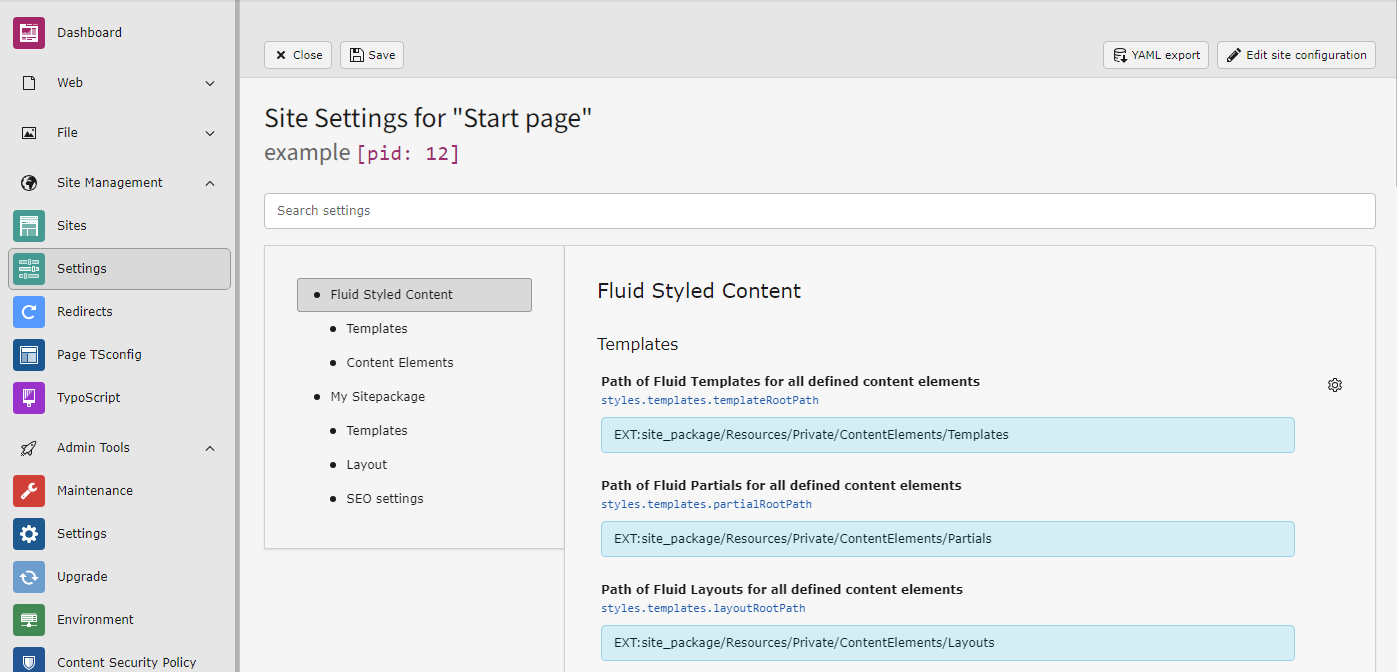Overriding the default templates of content elements
The content elements that are rendered up to this point are rendered by the TYPO3 system extension Fluid Styled Content ( typo3/cms-fluid-styled-content ).
This extensions offers default templates to render content elements. Without such an extension, no content would be rendered at all. The default templates provided by this extension can be overridden with site settings provided by Fluid Styled Content.
Your site package, if generated by the Site Package Builder already overrides two templates from Fluid Styled Content and you are free to override additional ones.
Use Settings to override template paths of Fluid Styled Content
Your site package already configures the paths to override the templates of
Fluid Styled Content content elements in file
packages/:
styles.templates.layoutRootPath: EXT:my_site_package/Resources/Private/ContentElements/Layouts
styles.templates.partialRootPath: EXT:my_site_package/Resources/Private/ContentElements/Partials
styles.templates.templateRootPath: EXT:my_site_package/Resources/Private/ContentElements/Templates
styles.content.textmedia.maxW: 1200
styles.content.textmedia.maxWInText: 600
styles.content.textmedia.linkWraplightboxEnabled: true
styles.content.textmedia.lightboxCssClass: lightbox
If you wanted to create this file yourself you could do it as follows:
Site settings can be saved both in the site configuration and in the site package extension.
We will save the settings to the site package but use the settings editor to write the YAML for us.
Go to module Site Management > Settings and edit the settings of your site. Override the paths to the templates of Fluid Styled Content like this:

Override the templates of Fluid Styled Content
If you would click Save now, the settings would be saved to your
site configuration at config/. We however
want to save the settings to the site set of our site package extension.
Click the button YAML export to copy the configuration to your Clipboard instead, then save it to the following file:
styles:
templates:
templateRootPath: 'EXT:my_site_package/Resources/Private/ContentElements/Templates'
partialRootPath: 'EXT:my_site_package/Resources/Private/ContentElements/Partials'
layoutRootPath: 'EXT:my_site_package/Resources/Private/ContentElements/Layouts'Override the sitemap template
In a similar fashion we now copy and adjust the template for the sitemap from
vendor/
into folder packages/
and then adjust it:
<html xmlns:f="http://typo3.org/ns/TYPO3/CMS/Fluid/ViewHelpers" data-namespace-typo3-fluid="true">
<f:layout name="Default" />
<f:section name="Main">
<f:render section="Menu" arguments="{menu: menu, level: 1}" />
</f:section>
<f:section name="Menu">
<f:if condition="{menu}">
<ul class="list-group ps-4 mt-2">
<f:for each="{menu}" as="page">
<li class="list-group-item">
<a href="{page.link}" class="text-decoration-none text-dark level-{level}{f:if(condition: '{level} < 2', then: ' fw-bold')}">
<span>{page.title}</span>
</a>
<f:render section="Menu" arguments="{menu: page.children, level: '{level + 1}'}" />
</li>
</f:for>
</ul>
</f:if>
</f:section>
</html>
We want to adjust the HTML output of the sitemap for different levels. The original template however gives us no means to output the level.
Line 5 uses the ViewHelper Render ViewHelper <f:render> to render everything in the section defined in lines 8-23.
In the original template the argument menu was already passed on as variable to
the section. We now enhance this line to also pass on variable level set to 1.
In line 17 the section Menu recursively includes itself to display further
levels of the sitemap. We now add 1 to the level so that within the recursive
call we are in level 2.
In line 14 we use that level to determine which class to use for the page link, using once more the Fluid inline notation of the If ViewHelper <f:if>.
Override the partial template for image rendering
The templates of some content elements use the Render ViewHelper <f:render> to include a partial template. This is true wherever images are displayed for example.
Partials in turn can include different partials.
The templates for "Image" and "Textpic" both contain the following line:
<f:render partial="Media/Gallery" arguments="{_all}" />If you open that partial, it includes yet another partial:
<f:render partial="Media/Type" arguments="{file: column.media, dimensions: column.dimensions, data: data, settings: settings}" />Which contains another until we finally arrive at
vendor/
which does contain the actual Media ViewHelper <f:media>.
By overriding this one partial we can add a class to all images that are
displayed with the "Image" or "Text with Media" content elements. For example
we could display all images as circles by adding the class rounded-:
<html xmlns:f="http://typo3.org/ns/TYPO3/CMS/Fluid/ViewHelpers" data-namespace-typo3-fluid="true">
<f:media class="image-embed-item rounded" file="{file}" width="{dimensions.width}" height="{dimensions.height}" alt="{file.alternative}" title="{file.title}" loading="{settings.media.lazyLoading}" decoding="{settings.media.imageDecoding}" />
</html>

